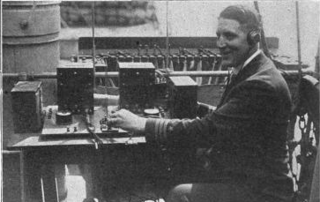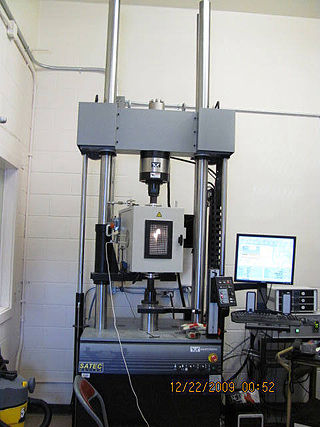A nuclear electromagnetic pulse is a burst of electromagnetic radiation created by a nuclear explosion. The resulting rapidly varying electric and magnetic fields may couple with electrical and electronic systems to produce damaging current and voltage surges. The specific characteristics of a particular nuclear EMP event vary according to a number of factors, the most important of which is the altitude of the detonation.

An electric unicycle is a self-balancing personal transporter with a single wheel. The rider controls speed by leaning forwards or backwards, and steers by twisting or tilting the unit side to side. The self-balancing mechanism uses accelerometers, gyroscopes, and a magnetometer. In 2020, suspension models were introduced by three major manufacturers Begode, Kingsong and Inmotion.

An electric vehicle (EV) is a vehicle that uses one or more electric motors for propulsion. It can be powered by a collector system, with electricity from extravehicular sources, or it can be powered autonomously by a battery. EVs include, but are not limited to, road and rail vehicles, surface and underwater vessels, electric aircraft, and electric spacecraft. For road vehicles, together with other emerging automotive technologies such as autonomous driving, connected vehicles, and shared mobility, EVs form a future mobility vision called Connected, Autonomous, Shared, and Electric (CASE) Mobility.

Elihu Thomson was an English-born American engineer and inventor who was instrumental in the founding of major electrical companies in the United States, the United Kingdom and France.

Ultra low frequency (ULF) is the ITU designation for the frequency range of electromagnetic waves between 300 hertz and 3 kilohertz, corresponding to wavelengths between 1,000 to 100 km. In magnetosphere science and seismology, alternative definitions are usually given, including ranges from 1 mHz to 100 Hz, 1 mHz to 1 Hz, and 10 mHz to 10 Hz.
The impact factor (IF) or journal impact factor (JIF) of an academic journal is a scientometric index calculated by Clarivate that reflects the yearly mean number of citations of articles published in the last two years in a given journal, as indexed by Clarivate's Web of Science.
General Atomics (GA) is an American energy and defense corporation headquartered in San Diego, California, specializing in research and technology development. This includes physics research in support of nuclear fission and nuclear fusion energy. The company also provides research and manufacturing services for remotely operated surveillance aircraft, including the Predator drones, airborne sensors, and advanced electric, electronic, wireless, and laser technologies.

Vehicle-to-grid (V2G), also known as Vehicle-to-home (V2H), describes a system in which plug-in electric vehicles (PEV) sell demand response services to the grid. Demand services are either delivering electricity or by reducing their charging rate. Demand services reduce pressure on the grid, which might otherwise experience disruption from load variations. Vehicle-to-load (V2L) is related, but the AC phase is not sychronised with the grid, so the power is only available to an "off grid" load.

Building science is the science and technology-driven collection of knowledge in order to provide better indoor environmental quality (IEQ), energy-efficient built environments, and occupant comfort and satisfaction. Building physics, architectural science, and applied physics are terms used for the knowledge domain that overlaps with building science. In building science, the methods used in natural and hard sciences are widely applied, which may include controlled and quasi-experiments, randomized control, physical measurements, remote sensing, and simulations. On the other hand, methods from social and soft sciences, such as case study, interviews & focus group, observational method, surveys, and experience sampling, are also widely used in building science to understand occupant satisfaction, comfort, and experiences by acquiring qualitative data. One of the recent trends in building science is a combination of the two different methods. For instance, it is widely known that occupants’ thermal sensation and comfort may vary depending on their sex, age, emotion, experiences, etc. even in the same indoor environment. Despite the advancement in data extraction and collection technology in building science, objective measurements alone can hardly represent occupants' state of mind such as comfort and preference. Therefore, researchers are trying to measure both physical contexts and understand human responses to figure out complex interrelationships.

Tomsk State University of Control Systems and Radioelectronics is a public university in Tomsk, Russia. Founded in 1962, TUSUR University was formed when two faculties, the Faculty of Radio Engineering and the Faculty of Electric Radio Control, split from Tomsk Polytechnic University to create a new educational institution. The mission of TUSUR as an entrepreneurial research university is “to create cultural, educational, research and innovative environment, ensuring achievement of success by alumni whose labor and knowledge guarantee that high technologies serve the country, society and the world”.

Molten-salt batteries are a class of battery that uses molten salts as an electrolyte and offers both a high energy density and a high power density. Traditional non-rechargeable thermal batteries can be stored in their solid state at room temperature for long periods of time before being activated by heating. Rechargeable liquid-metal batteries are used for industrial power backup, special electric vehicles and for grid energy storage, to balance out intermittent renewable power sources such as solar panels and wind turbines.

Spacecraft electric propulsion is a type of spacecraft propulsion technique that uses electrostatic or electromagnetic fields to accelerate mass to high speed and thus generate thrust to modify the velocity of a spacecraft in orbit. The propulsion system is controlled by power electronics.
Ashok Jhunjhunwala is an Indian academic. He received his B.Tech. from the Indian Institute of Technology, Kanpur and PhD from the University of Maine. He has been a faculty member at the Indian Institute of Technology Madras since 1981, where he is currently Institute Professor. During his career, he has contributed extensively to technology innovation and adoption in the Indian context.
CSA was a division of Cambridge Information Group and provider of online databases, based in Bethesda, Maryland before merging with ProQuest of Ann Arbor, Michigan in 2007. CSA hosted databases of abstracts and developed taxonomic indexing of scholarly articles. These databases were hosted on the CSA Illumina platform and were available alongside add-on products like CSA Illustrata. The company produced numerous bibliographic databases in different fields of the arts and humanities, natural and social sciences, and technology. Thus, coverage included materials science, environmental sciences and pollution management, biological sciences, aquatic sciences and fisheries, biotechnology, engineering, computer science, sociology, linguistics, and other areas.

The Edward E. Whitacre Jr. College of Engineering is the college of engineering at Texas Tech University in Lubbock, Texas. The engineering program has existed at Texas Tech University since 1925. Additionally, the Whitacre College of Engineering administers graduate engineering degree programs at the university's campus in Amarillo, Texas. Many of the college's degree programs are accredited by ABET. The Whitacre College of Engineering is the first and, presently, only school in the world to offer a doctor of philosophy degree in wind science and engineering.
The watt is the unit of power or radiant flux in the International System of Units (SI), equal to 1 joule per second or 1 kg⋅m2⋅s−3. It is used to quantify the rate of energy transfer. The watt is named in honor of James Watt (1736–1819), an 18th-century Scottish inventor, mechanical engineer, and chemist who improved the Newcomen engine with his own steam engine in 1776. Watt's invention was fundamental for the Industrial Revolution.

Plasma is one of four fundamental states of matter, characterized by the presence of a significant portion of charged particles in any combination of ions or electrons. It is the most abundant form of ordinary matter in the universe, being mostly associated with stars, including the Sun. Extending to the rarefied intracluster medium and possibly to intergalactic regions, plasma can be artificially generated by heating a neutral gas or subjecting it to a strong electromagnetic field.

Nuclear power in space is the use of nuclear power in outer space, typically either small fission systems or radioactive decay for electricity or heat. Another use is for scientific observation, as in a Mössbauer spectrometer. The most common type is a radioisotope thermoelectric generator, which has been used on many space probes and on crewed lunar missions. Small fission reactors for Earth observation satellites, such as the TOPAZ nuclear reactor, have also been flown. A radioisotope heater unit is powered by radioactive decay and can keep components from becoming too cold to function, potentially over a span of decades.
An electromagnetic pulse (EMP), also a transient electromagnetic disturbance (TED), is a brief burst of electromagnetic energy. The origin of an EMP can be natural or artificial, and can occur as an electromagnetic field, as an electric field, as a magnetic field, or as a conducted electric current. The electromagnetic interference caused by an EMP can disrupt communications and damage electronic equipment. An EMP such as a lightning strike can physically damage objects such as buildings and aircraft. The management of EMP effects is a branch of electromagnetic compatibility (EMC) engineering.
Mangalore Anantha Pai was an Indian electrical engineer, academic and a Professor Emeritus at the University of Illinois at Urbana–Champaign. A former professor of electrical engineering at the Indian Institute of Technology, Kanpur, he is known for his contributions in the fields of power stability, power grids, large scale power system analysis, system security and optimal control of nuclear reactors and he has published 8 books and several articles. Pai is the first India born scientist to be awarded a PhD in Electrical Engineering from the University of California, Berkeley.











